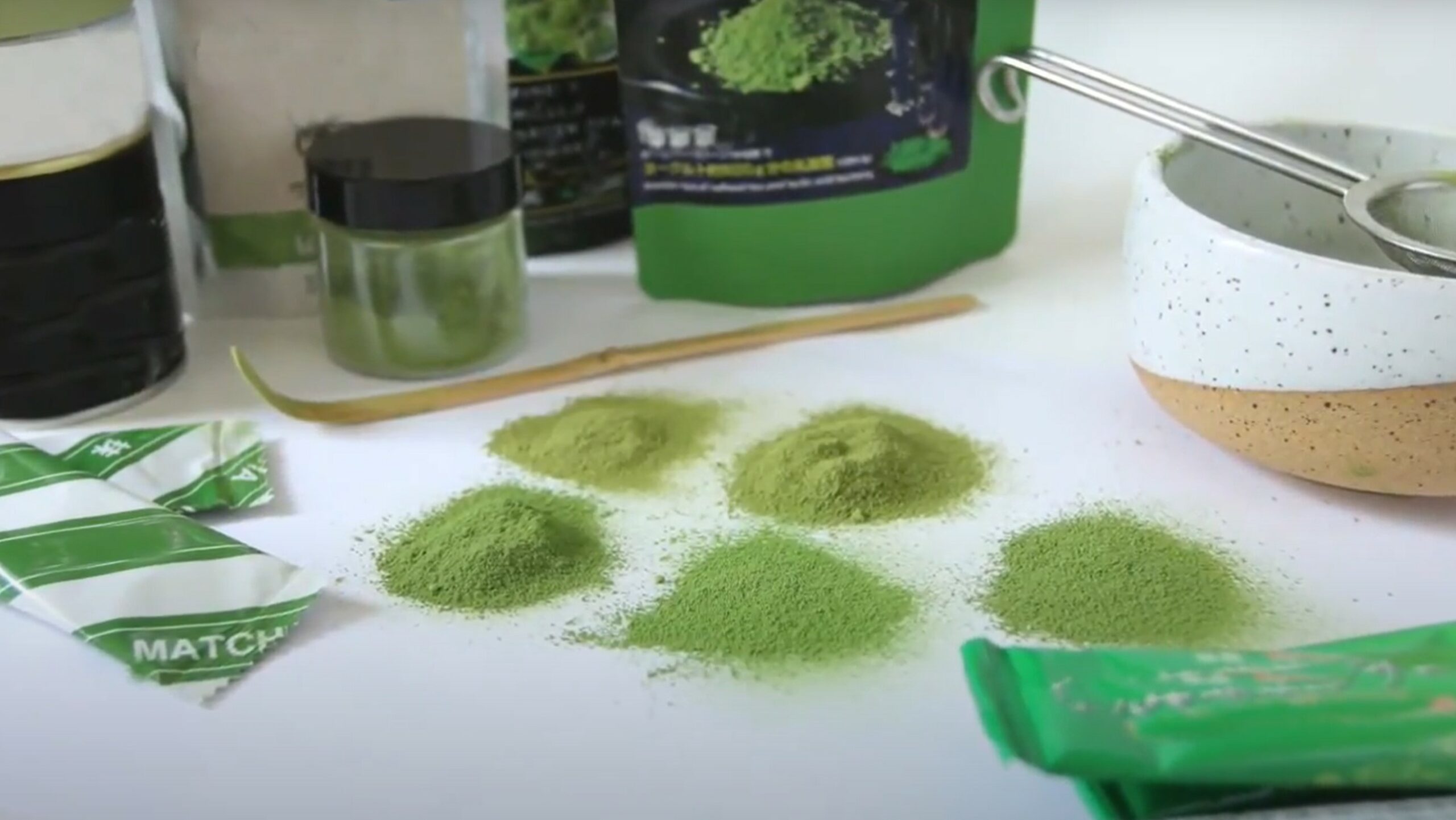What Does Matcha Taste Like? How To Get The Best Cup of Green Tea
What does Matcha taste like? It’s vegetal with a grassy flavor, slightly sweet, smooth, and has a full-textured mouthfeel. When you buy high quality ceremonial grade Matcha, it has a umami flavor because of Matcha’s glutamate and amino acids.
When Matcha tea is grown and processed properly, it has a vibrant green color because of the chlorophyll plus a fresh aroma.
If you’ve ever tried Matcha and it had a bitter taste, then you probably had a lower grade of Matcha called culinary grade Matcha. This grade of Matcha is better as a Matcha latte, baked goods, or smoothies with added sugar.
Getting Matcha to have the best taste profile depends on the expertise of the tea farmer, grade of green tea, and brewing process.
To get the highest quality Matcha tea with the best flavor profile, you need to use Japanese Ceremonial grade Matcha.
What Does Matcha Taste Like: Japanese Ceremonial Grade
The first sip of high quality ceremonial grade Matcha is a rich and savory umami flavor that feels full of texture in your mouth. Then, you’ll notice the slightly sweet and vegetal flavor followed by slight bittersweet astringent notes. The aftertaste is reminiscent of savory nutty tastes and it will linger on your palate then begin to gradually disappear.
Matcha is known for it’s umami, or “pleasant taste.” Umami is a savory flavor and is considered the 5th flavor, along with sour, bitter, sweet, and salty. It is created by the glutamate in the tea.
It’s best enjoyed with just hot water without sugar or milk.
Japan is the only place where the best ceremonial grade Matcha green tea is grown and cultivated properly. This is because it is used in traditional Japanese Tea Ceremonies and is an important part of Japanese culture.
If you’ve ever tried Matcha and it was bitter; you may have had Culinary grade Matcha. It is a lower quality green tea and drinking this Matcha usually has a bitter taste. It is best used in baked goods, smoothies, or Matcha lattes with milk.
Ceremonial grade Matcha is the best quality you can get. Which also makes it more expensive.
Cultivation Practices For The Best Matcha Taste
Growing ceremonial grade Matcha that tastes like it is supposed to is a complicated process. So it takes an experienced Japanese tea farmer with an established crop to get the flavor just right.
It starts with the Camellia sinensis plant which is shaded 30-40 days before harvest in early spring. This protects it from overexposure to sunlight and gives Matcha it’s bright green color. If it is not protected from sunlight before harvest, Matcha will taste bitter and lose it’s antioxidants, amino acids, and many of it’s health benefits.
Ceremonial grade Matcha is plucked only once a year, instead of multiple times a year like culinary grade Matcha, which means the plants are healthier and produce better leaves.
Processing Matcha Tea Leaves
On the day the young tender tea leaves, or tencha, are plucked; they are steamed.
Steaming prevents oxidation which would turn them into black tea. It also maintains their vibrant green color because it preserves the chlorophyll and stops fermentation enzymes.
Then the tencha are spread out and exposed to wind. This cools and partially dries them.
Next, the stems are removed and sorted. The tea leaves are only considered Matcha once the tencha are turned into powder.
Turning the tencha into Matcha tea powder is a tedious and painstaking process. The leaves are stone ground in a counterclockwise motion by hand. Using an automated grinder would be much faster but it’s not the traditional way to make Matcha powder.
It takes an hour to make just 40 grams (1/2 cup) of ground Matcha powder by hand.
How To Know You’re Buying High Quality Matcha
When cultivation and processing of Matcha green tea is done properly, the finished Matcha tea powder will have retained it’s chlorophyll, the amino acids, fiber, nutrients, and glutamine. These properties are what gives Matcha it’s health benefits. And you can tell by the way this Japanese green tea looks.

The Best Quality Ceremonial Grade Matcha Tea Powder
- Bright green
- Very fine powder similar to baby powder
- Has a pleasant aroma
Origin
Know your source. Only buy Matcha that is farmed and processed in Japan. Cheaper Matcha green teas are grown and processed in China, which doesn’t have the high standards of Japanese farmers. This results in a Matcha tea that tastes bitter or even fishy.
Grade
There are 2 grades of Matcha: Ceremonial and Culinary.
Ceremonial grade Matcha is best enjoyed without added milk or sugar. These green tea leaves, or tencha, are traditionally cultivated and processed for the Japanese tea ceremony. Matcha farmers value the quality of their green tea over quantity.
Culinary grade Matcha tastes bitter when drinking with just hot water, which means it needs added sugar or milk. Matcha lattes, baked goods, and smoothies taste like Matcha, sort of, but don’t have the purity of flavor like the higher quality grade. It is bitter when drinking it alone as a tea. Culinary grade Matcha is harvested up to 3 times a year and does not have the same high standards for processing and cultivation like ceremonial Matcha.
Organic
The best Matcha is organic. Because you are drinking the whole tea leaf and taste is so important, don’t settle for conventional Matcha that has been sprayed with pesticides.
Color
The more vibrant the green color of Matcha powder, the better the taste will be. Bright green Matcha means the plant was shaded properly and the chlorophyll is intact. You’ll get the sweet, nutty, and smooth taste of Matcha.
Matcha green tea with brown hues means it has oxidized. It was either not grown properly and the leaves were overexposed to sunlight, not processed properly, or not stored properly before being sold. It will taste bitter and lack the sweetness of bright green Matcha.
Matcha Tasting Notes
Matcha tastes soft, sour and almost buttery and it retains an impressive body with lingering aftertaste.
High levels of chlorophyll and an amino acid called L-theanine give Matcha its unique flavor. Unlike many teas which require sweeteners or milk, Matcha has its own sweetness so you don’t need sugar.
Vegetal Taste
The aroma of premium Matcha green tea has a grassy vegetal flavor. Matcha can have a much stronger taste “green tea” flavor due to its whole ground tea leaves.
Smoothness
Matcha tea has a smooth full-mouth texture and froth. Because you are drinking 100% of the tea leaf, you will get the stone ground leaves which give you the full-bodied texture.
Bittersweet
Matcha has an earthy bitterness with a subtle, lingering sweetness. While pure ceremonial Matcha won’t be as sweet as a Matcha latte, it does have a light natural sweetness that helps to balance out the other strong flavor notes in this unique tea.
In the traditional Japanese tea ceremony, Matcha is often served alongside small sweets, which help to accentuate the sweetness naturally present in the tea.
Astringent
Matcha green tea also has a pleasantly astringent bite. Drinking Matcha is not overwhelmingly astringent, like regular green tea, but it’s just enough to make the taste of Matcha even more interesting.
What are the Health Benefits of Matcha?
You know you’re getting all the health benefits Matcha has to offer when you buy ceremonial grade high quality Matcha from Japan. Matcha is considered a superfood for it’s polyphenol antioxidants which are known to prevent cancer and inflammation with can lead to a host of diseases.
Matcha For Stress
Matcha is rich in antioxidants, fiber, nutrients, and an amino acids called L-theanine. L-theanine gives you a feeling of overall well being and calmness. But it you’re looking to wake up in the morning, Matcha has caffeine, too. Depending on the amount of Matcha in each cup, it has just as much caffeine as coffee, or more.
Matcha Green Tea For Skin
Matcha contains many nutrients, antioxidants and anti-inflammatory properties. Matcha is high in the antioxidant catechins (EGCG) and has been shown to be effective in preventing and reducing skin inflammation.
Matcha Green Tea For Weight Loss
Matcha can help with weight loss and obesity. It contains high levels of the antioxidant catechins (including EGCG), which have been shown to have an effect on weight loss by stimulating metabolism and fat burning. It can also help regulate hormones that are associated with obesity.
Matcha Green Tea for PCOS
Matcha green tea can help with symptoms of PCOS, or Polycystic Ovary Syndrome. It can help decrease the testosterone levels associated with the disease, increase fertility, and reduce pain.
How to Make Matcha Green Tea
Ceremonial Grade Matcha Recipe
Now that you know how to buy the best quality Matcha tea powder from Japan, make sure you brew it right to get the best taste. Ceremonial grade Matcha is traditionally whisked with hot water and a bamboo Matcha whisk until frothy.
INGREDIENTS
1 teaspoon ceremonial Matcha powder (I use Gold Matcha)
4oz hot spring water, cooled from boiling
Tools
Bamboo Matcha whisk
INSTRUCTIONS
- Add 1 teaspoon of Matcha powder to your cup (I like cups with rounded bottoms because they are much easier whisk)
- Bring 4oz water to 160°F, or bring spring water to boil and let it cool for a few minutes in the kettle
- Pour the water over the Matcha tea.
- Use the whisk to gently dab the tea, then whisk in circles to distribute it around the cup. Without letting the whisk touch the bottom of the cup, whisk the Matcha vigorously back and forth for a few minutes until it gets nice and frothy. Then, slow the whisk down to gentle circles again to reduce big bubbles to foam.
- Serve warm and drink Matcha within a few minutes to prevent settling.`
Final Thoughts
Now that your question, “what does Matcha taste like” has been thoroughly explained, we invite you to taste Matcha again, or for the first time. You now know to only buy Matcha organic from an established Japanese farm and what to look for in a high quality Matcha green tea. It should be a vibrant green tea to avoid oxidation or overexposure to sunlight.
The taste of Matcha should be nutty, vegetal with a grassy flavor, slightly sweet, smooth, and give you a full textured mouthfeel. Ceremonial grade Matcha should not have bitterness when grown properly. This high quality Matcha tastes better than culinary grade Matcha, which is best used for a Matcha latte made with milk.
Prepare Matcha with boiling water cooled to hot water then add the stone ground Matcha powder. Whisk until frothy and drink the cup of Matcha within a few minutes to avoid settling. This ensures you’ll get a cup full of health benefits.
Matcha has antioxidants, nutrients, and the amino acid L-theanine are the best Matcha benefits for your health. For some people, it can help reduce symptoms of PCOS, improve skin health, reduce stress, and reduce the risks of developing diseases associated with inflammation, like cancer.
We like organic Gold Matcha tea from Japan. It meets all of these criteria and tastes great.

